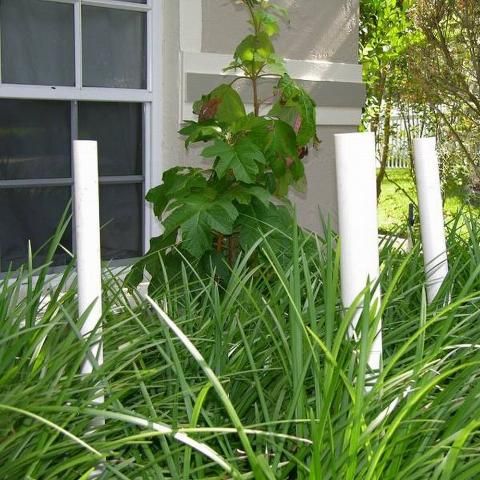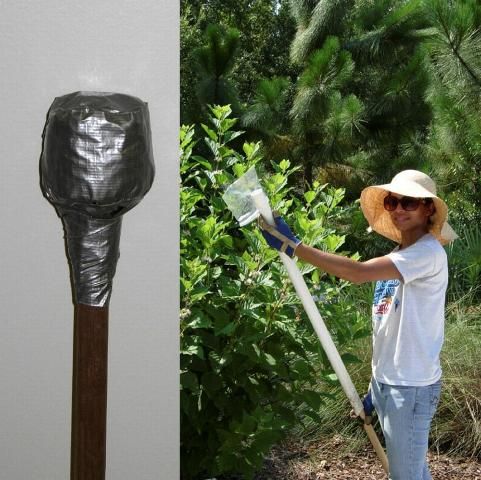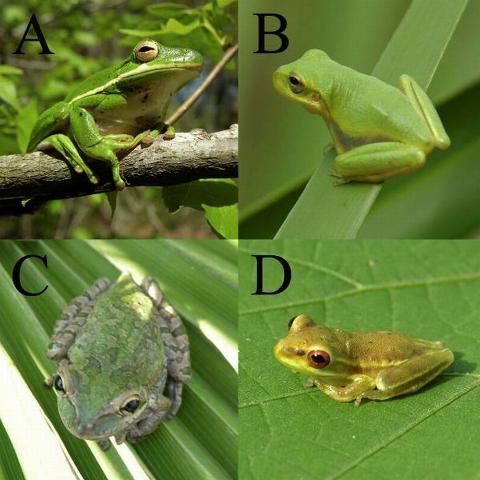When humans change natural habitats by building houses and roads, wildlife sometimes needs a helping hand to survive. Some people plant gardens for butterflies, dig ponds for frogs, or build houses for birds and bats. In Florida you can help native treefrogs by building houses for them. Treefrog houses give the frogs a shady, safe place to hang out during the day, and a place to sit at night and watch for tasty roaches, beetles, and spiders. In neighborhoods, people sometimes let their cats live or play outside, because they do not understand that cats eat millions of Florida's birds, lizards, and frogs every year. Treefrog houses can help to protect treefrogs from cats and other animals that might try to eat them. You can also help native treefrogs by watching out for invasive Cuban treefrogs—they like to hang out in treefrog houses too, and they eat native treefrogs! Making a treefrog house is easy—you just need a few supplies from a hardware store and a little help from an adult.
Please note: In the western United States, uncapped PVC pipes used to mark mining claims pose a serious threat to birds that become trapped inside; however, accidental bycatch of PVC treefrog houses is not a problem in Florida. The PVC treefrog houses described in this fact sheet should be used only in Florida. If you are located in another state, please contact your local UF/IFAS Extension office for advice on native frog conservation.
What You Will Need
For Each Frog House
- A three-foot length of white plastic PVC pipe (Get the kind with thin walls: it should be 1.25 inches in diameter)
- A saw for cutting the pipe (and an adult to use the saw)
- Permanent markers or paint pen
To Check the Frog House
- An old broomstick or a dowel rod (at least three feet long)
- A sponge or an old washcloth
- Duct tape
- Plastic zipper bags
Making and Decorating Your Treefrog House
To make your frog house, ask an adult to cut one end of the three-foot PVC pipe at a slant (45 degrees), or have it cut at the hardware store. That is it—now you have a treefrog house! Use permanent markers or paint pens to decorate your treefrog house (Figure 1).

Credit: Monica McGarrity, UF/IFAS
Setting up Your Treefrog House
Find the perfect place for your treefrog house—in a flower bed or near shrubs, trees, or other tall plants. Treefrogs like to hang out in plants because there are plenty of hiding places, lots of bugs to eat, and branches where they can just sit and wait for the bugs to crawl by. Put the new treefrog house near plants to help the treefrogs find it. When you find the right spot, ask an adult to help you use a rubber mallet to hammer the slanted end of the pipe into the ground so that the pipe stands up on its own (Figure 2). Check your treefrog house for frogs by peeking in the top (Figure 3). If treefrogs do not move in within a couple of weeks, try moving your treefrog house to a new spot.

Credit: Steve A. Johnson, UF/IFAS

Credit: Monica E. McGarrity, UF/IFAS
Catching Treefrogs
Make a "frog plunger" by wrapping a sponge or an old washcloth around one end of an old broomstick or dowel rod and attaching it with duct tape (Figure 4). The fat end of your plunger should fit the inside of the pipe. When you find a frog in the pipe, put a plastic zipper bag over the top of the pipe and zip it closed so the frog cannot sneak out. Check to see if the slanted end of the pipe is clogged with dirt, and if it is then use a small stick to remove the dirt and any debris before inserting the frog plunger. Carefully pull the pipe out of the ground. Then very slowly and gently slide the fat end of your frog plunger into the slanted end of the pipe and use it to slowly nudge the frog into the bag (Figure 4). Peek through the bag into the treefrog house while you are plunging to be sure the frog is hopping along okay. Try not to touch the frog with the plunger if you can help it because its legs could get caught. If your frog is a real homebody, you might need to give the frog a little nudge in the rear with the plunger. Be patient—soon you will be an expert frog plunger!

Credit: Monica E. McGarrity, UF/IFAS
When you have gotten the frog in the bag, pull the bag off of the pipe and zip it closed. Do not ever try to catch or hold a treefrog with your bare hands, since it could be an invasive Cuban treefrog. The skin of Cuban treefrogs oozes slimy mucus that helps them slip away from predators and will burn your eyes and make you sneeze! Be sure you do not keep the frog in the bag for more than ten minutes, and keep it in the shade or inside. Never leave the bagged frog out in the sun!
You might find native green or squirrel treefrogs, or invasive Cuban treefrogs (Figure 5) using your treefrog house. Take the frog inside, and look at the pictures below (or on our treefrog website, https://ufwildlife.ifas.ufl.edu/frogs/florida.shtml) to figure out what kind of frog it is. If it is a native treefrog, you can put it back in the treefrog house. If the frog is not native, give it to an adult who is not afraid of frogs or any other creepy crawlies—you know, the one you call when there is a big spider in your room!

Credit: Steve A. Johnson and Esther Langan, UF/IFAS
Note to Adults
Cuban treefrogs are causing harm to our native ecosystem in ways that we have only begun to understand, and are causing native treefrog populations to decline. They have also become an urban pest, showing up in toilets, clogging drains, and leaping from doorways onto unsuspecting passers-by. They can do considerable economic damage by short-circuiting utility switches and causing expensive power outages. Their skin secretes slimy mucus that can burn the eyes and nose and cause allergy symptoms or trigger an asthma attack. Do not allow children to handle these frogs with bare hands! We recommend that you learn more about these frogs and how you can use treefrog houses to remove these noxious pests from your yard so they do not hang around (and possibly enter) your home. By removing Cuban treefrogs, you can help Florida's native treefrogs survive in suburbia. For more information on Cuban treefrogs, please take the time to read The Cuban Treefrog in Florida, online at https://edis.ifas.ufl.edu/publication/UW259.